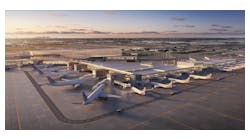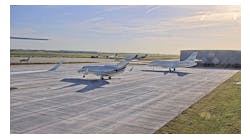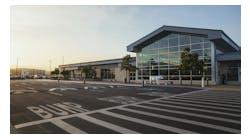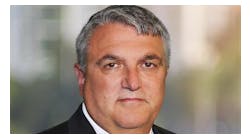After Emotional Testimony, Boise Commission Divided on Rezoning Open Space Near Airport
Mar. 15—One by one, neighbors stepped up to the podium. Some with prepared comments, some with tears welling up. Each explained the value — priceless — they place on the "permanent open space" just east of South Umatilla Avenue in Southwest Boise.
They fear that land being developed into an industrial park.
At Boise's Planning and Zoning Commission meeting Monday night, 46 people testified against the proposed rezoning of 153 acres in a horizontal rectangle of land owned by the Boise Airport that's now designated as open space. The proposal calls for turning the land into an industrial park, which neighbors say would wreck wildlife habitats, eliminate a place to admire nature and ding home values.
"East of our neighborhood is an important and valuable parcel of land," South Umatilla Avenue resident Susan Moore said while choking back tears. Four generations of Moore's family have lived in the neighborhood. She cherishes seeing wildlife just beyond her backyard. "More meaningful than money or any industrial site could ever bring to our valley," Moore said. "Once it's gone, it's gone forever."
After more than three hours of discussion, the commission voted 4-2 to recommend rezoning 75.5 of the acres to allow light industrial development but denying the request to rezone the 77.5 remaining acres.
Though uncertainty remains about what may come next, the recommendation gives the neighbors progress toward what they want. Many testified specifically against rezoning the westernmost land closest to Umatilla Avenue rather than the entire 153 acres. The eastern piece of land would be developed, but that's farther from the neighbors, closer to the airport and would be less disruptive.
While both halves are already designated for open land, the eastern half is zoned A-1, which is considered a holding zone until future development. The western half is A-2, intended for "permanent open space," according to city code.
The recommendation now goes to the City Council, which decides all zoning changes.
Before Monday's hearing, the airport was required to include a development agreement as part of its application, but commissioners lifted that requirement. The agreement included requirements for extra space next to houses and said loading docks must face the opposite direction of homes.
Commissioners lifted the requirement because it was mostly centered around protecting homeowners along the western edge of the land. Since they recommended denying the rezoning there, a development agreement wouldn't be as important anymore.
That left South Cole Neighborhood Association President Estee Lefrenz uncertain, but she said the recommendation to preserve the permanent open space is "a good thing."
"I think they heard a lot of the testimony from the community and realized that not only is the community not in favor of having the industrial development," Lefrenz told the Idaho Statesman, "the community really, truly loves that open space. I think that was obvious."
South Umatilla Avenue is part of unincorporated Ada County, just barely outside Boise city limits. It's close enough to still be significantly affected by the decisions of Boise's government.
The Boise Airport proposed the rezoning to allow for the industrial park to fill the unoccupied land. The airport is run by the city, which has already picked Boise-based Adler Industrial as its preferred developer.
In response to the city's request for information, Adler Industrial projected it could draw $3.3 million in property tax revenue annually. The financial gain has been the main driver for the airport's application.
The land is set aside for industrial on Boise's land use map, which guides future development. That's a key point the city's planning staff and airport employees have made. They argue the future designation is more important than the current zoning and that light industrial is allowed to be next to residential.
Neighbors have mostly come to terms with development on the easternmost 75.5 acres of open space. They've recognized it's a holding zone until development happens. What they've vehemently opposed is building on the "permanent" open space.
Monday's recommendation is an indication the airport has more details to sort out.
"We're excited to be able to move forward with the parcels that are A-1, and we understand the concerns related to A-2," Boise Airport Director Rebecca Hupp told the Statesman. "We do think there is an opportunity to make sure the development is compatible with the neighborhood. That's always our intent. I think that change is uncertain, and people want certainty."
Commissioners seek more details
Before Monday's final vote, Commissioner Jennifer Mohr proposed recommending denial of the entire project, because it lacked a conceptual site plan. That was voted down 4-2.
Commissioner Ashley Squyres said she's been involved in land use planning for 22 years and has "never seen a project this large ... without a concept plan, without more details." She was the only one to vote with Mohr.
Squyres said it's in the city's best interest to listen to neighbors' feedback.
"Just dealing with the A-1 is the simplest and most straightforward recommendation," Commissioner Milt Gillespie said. "I think it gives the applicant and the city time to think harder about the A-2 between this hearing and the next."
The proposed rezoning has been in the works for months. At a January public hearing, a decision was delayed until February so the airport could have more time to work out a development agreement. In February, the airport requested more time.
The development agreement presented Monday included a 100-foot buffer from the property line on the western edge behind 14 homes on South Umatilla Avenue. That was an increase from the previously proposed 60-foot buffer.
But the airport's representatives, Hupp and Property and Contracts Manager Amy Snyder, didn't provide further details on plans for the industrial park.
Without that, Squyres and Mohr expressed hesitancy with the project moving forward. They wanted to see more details about what is planned to be built if the rezoning passed.
The other four commissioners were OK with the eastern half of the rezoning, but not the western half.
Neighbors oppose rezoning
Only representatives of the airport and city planning staff testified in favor of the airport proposal.
Neighbors expressed concerns over preserving picturesque views of the Foothills, breathing in pollution from diesel-fueled trucks and losing value on their homes. Based on estimates they said they received from experts, neighbors said each of their homes would lose about $100,000 in value if the industrial park was built on the permanent open space land.
They also repeatedly questioned the definition of "permanent" and said they're worried about the precedent that could be set.
"When permanent means something other than permanent, how can we trust anything the city tells us?" neighbor Julie Lynde said.
Chelsea Eller, who identified as part of the area's youth, is involved with 4-H, which works with the horses from the Western Riding Club just north of the land in the proposal.
Eller said she's dealt with anxiety and depression, and the only time she's been able to escape that is on the back of a horse. If the proposal is approved, the 4-H club wouldn't survive right next to an industrial park, she said.
"(Riding my horse) is the only time I truly feel peace," Eller said, "and the only time I get to look over the Sawtooth Mountains and up at Bogus or over to the Owyhee Mountains, watch the sunset go down and think to myself, 'Wow, I'm so glad that I'm still alive today.'"
___
(c)2022 The Idaho Statesman (Boise, Idaho)
Visit The Idaho Statesman (Boise, Idaho) at www.idahostatesman.com
Distributed by Tribune Content Agency, LLC.




